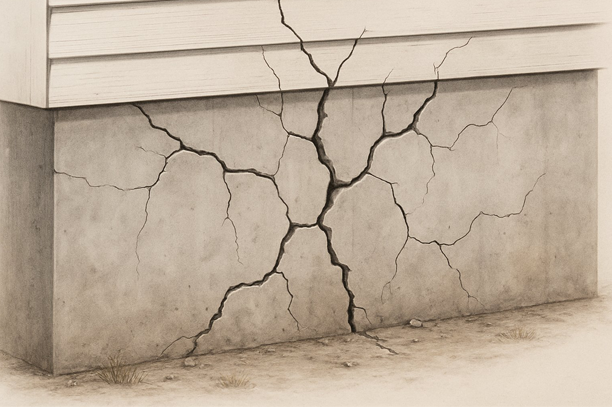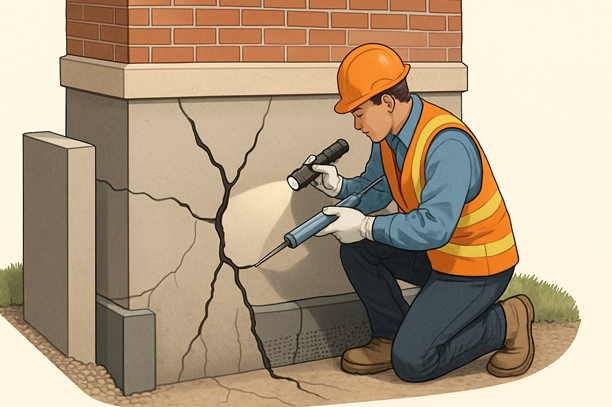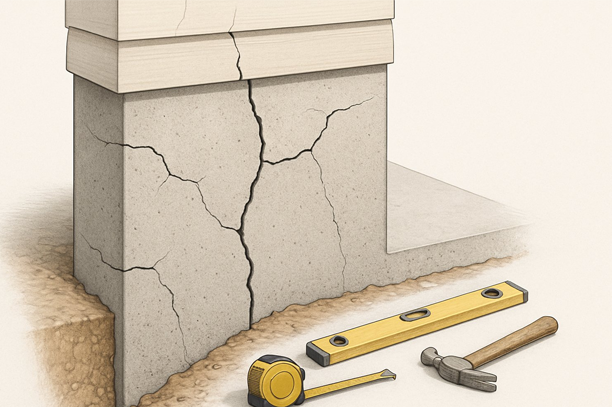Foundation Cracks: How to Identify & Fix Common Types in Homes & Buildings
Foundation cracks can signal serious structural issues in your home. Small hairline cracks might seem harmless, but they often indicate underlying problems that require professional attention. Ignoring cracks in your foundation can lead to costly repairs, decreased property value, and even unsafe living conditions.
Most damage to a foundation develops due to soil movement, water damage, or poor construction practices. While some settlement cracks are normal in new homes, horizontal cracks and those wider than 1/8 inch typically warrant immediate inspection. Seasonal changes and soil expansion can worsen existing cracks over time.
Early detection and proper repair can save homeowners thousands of dollars. Professional engineers use specialized equipment to determine the cause and severity of foundation damage before recommending appropriate solutions. Regular home inspections, proper drainage, and maintaining consistent soil moisture around your foundation help prevent these structural problems.
8 Types Of Foundation Cracks In Buildings And Homes
Cracked foundations come in various forms, each with different causes and levels of concern. Identifying the type of crack is the first step in determining whether it requires immediate attention or simple monitoring.
1. Vertical Cracks
These run up and down foundation walls and are among the most common foundation issues. They typically result from concrete shrinkage during the curing process. Most vertical cracks in a foundation don't pose serious structural concerns unless they exceed 1/8 inch in width.
Warning signs to watch for:
Water seepage through the crack
Widening over time
Displacement between the two sides
In block foundations, vertical cracks often follow the mortar joints between blocks. These may require different repair methods than cracks in poured concrete foundations.
Repair options for vertical cracks include:
Epoxy injections
Polyurethane foam
Hydraulic cement
Early intervention prevents water damage and keeps minor vertical cracks from developing into major problems.
2. Horizontal Cracks
Horizontal cracks in foundation walls are more serious than vertical ones. These cracks run side to side and often indicate significant structural problems.
The primary causes of horizontal cracks in a foundation include:
Excessive soil pressure against the foundation wall
Hydrostatic pressure from water buildup
Frost heaving in cold climates
In block foundations, horizontal cracks frequently appear along mortar joints. The wall may bow inward, creating a curve rather than a straight line.
Severity indicators:
Width exceeding 1/4 inch
Visible bowing or bulging
Multiple horizontal cracks on the same wall
Professional engineering assessment is essential for horizontal cracks. Repairs might involve carbon fiber straps, wall anchors, or steel bracing to prevent further movement.
3. Stair-Step Cracks
Stair-step cracks follow the mortar joints in block or brick foundations, creating a distinctive stair or zigzag pattern. These cracks typically indicate foundation settlement or movement.
The foundation section with the stair-step crack is usually sinking or shifting. Common causes include:
Uneven settling of the foundation
Poor soil compaction before construction
Excessive moisture causing soil expansion/contraction
Severity assessment factors:
Width of the crack
Amount of displacement
Whether the crack continues to grow
Stair-step cracks in block foundations often require professional repair. Solutions may include foundation underpinning, soil stabilization, or moisture management around the foundation.
Early detection of these cracks helps minimize repair costs and prevent additional structural damage.
4. Diagonal Cracks
Diagonal cracks run at roughly 30-75 degree angles across foundation walls. These cracks usually indicate uneven settling of the foundation, often due to soil issues.
Common causes of diagonal cracks in foundation include:
Soil that expands when wet and shrinks when dry
Tree roots drawing moisture from soil near the foundation
Poor drainage around one section of the foundation
Diagonal cracks are particularly concerning when they:
Exceed 1/4 inch in width
Show displacement (one side higher than the other)
Allow water infiltration
These cracks often start narrow at one end and widen toward the other end. The wider end typically points toward the area experiencing the most settlement.
Repair approaches depend on the underlying cause. Solutions may include improving drainage, installing root barriers, or foundation underpinning in severe cases.
5. Hairline Cracks
Hairline cracks are very thin (less than 1/16 inch wide) and occur in most concrete foundations. These tiny cracks typically result from normal concrete curing and shrinkage.
Key characteristics of hairline cracks:
Very narrow width
No displacement between sides
Often appear within the first year after construction
In most cases, hairline cracks don't compromise structural integrity. However, they can allow water seepage over time, especially in areas with high water tables.
Simple monitoring is usually sufficient for hairline cracks. Take photos with a ruler for scale every few months to check for widening. If the crack remains stable, it likely doesn't require repair.
For waterproofing purposes, even stable hairline cracks can be sealed with flexible crack sealants designed for concrete.
6. Wide Or Expanding Cracks
Wide cracks (exceeding 1/4 inch) or cracks that continue to expand indicate significant foundation problems. These cracks demand immediate professional attention.
Common causes of wide or expanding cracks in the foundation:
Major soil movement beneath the foundation
Structural overloading
Water damage is compromising the concrete
These serious cracks often exhibit:
Measurable widening over time
Leaking during rainstorms
Accompanying symptoms like sticking doors/windows
Document expanding cracks by measuring their width monthly. Mark the end points of the crack to monitor length increases.
Professional repair methods for wide cracks include:
1. Foundation piers or underpinning
2. Carbon fiber reinforcement
3. Steel bracing systems
4. Mudjacking or foam jacking
Ignoring wide or expanding cracks can lead to comprehensive structural failure and dramatically increased repair costs.
7. Map Or Crazing Cracks
Map cracks create a pattern resembling a road map across concrete surfaces. These shallow, interconnected cracks affect only the surface layer of concrete.
Map cracking typically results from:
Improper concrete mixing
Too much water in the concrete mix
Rapid drying during curing
These surface-level cracks rarely indicate structural problems. They affect appearance more than function in most cases.
Treatment options:
Concrete sealers to prevent water penetration
Resurfacing with a thin concrete overlay
Decorative options like epoxy coatings
Map cracks in foundation walls should still be monitored. If they deepen or widen over time, they may indicate developing structural issues requiring professional assessment.
8. Vertical Cracks At Corners
Vertical cracks at foundation corners often result from concrete shrinkage but can also indicate structural stress. Their location makes them particularly vulnerable to water intrusion.
Corner cracks frequently develop due to:
Different curing rates at the corner junction
Temperature fluctuations cause expansion/contraction
Settlement beneath the corner of the structure
Risk factors:
Width exceeding 1/8 inch
Displacement between crack sides
Water seepage or staining
Repairing corner cracks typically involves sealing with flexible materials that accommodate minor movement. Epoxy injection works for structural corner cracks, while polyurethane is better for waterproofing.
Common Causes Behind Damage to a Foundation
Cracks in the foundation often appear due to soil settlement. When the ground beneath a home shifts, it causes the foundation to move and crack. This is a natural process that affects many homes over time.
Concrete shrinkage is another major culprit. As concrete dries after construction, it can shrink slightly and form cracks. These typically appear within the first year after construction.
Poor drainage around a home leads to many foundation issues. Water pooling near the foundation puts pressure on walls and can cause cracking over time.
Drought conditions create problems too. Soil shrinks during dry periods, removing support from parts of the foundation. When rains return, uneven moisture levels cause stress on the structure.
Hydrostatic pressure occurs when water builds up in the soil around a foundation. This pressure pushes against foundation walls, eventually causing them to crack or bow inward.
Signs of foundation problems include:
Sticking windows and doors
Tilting chimneys
Uneven floors
Cracks in drywall
Gaps around window frames
Soil erosion removes support from beneath foundations. This often happens due to improper grading or water flow issues around the property.
Extreme temperature changes can stress concrete. When materials expand and contract repeatedly, small cracks develop and grow larger over time.
Tree roots sometimes contribute to foundation damage. Large trees near a home can draw moisture from the soil, causing it to shrink and shift the foundation.
Assessing Severity: What Warrants Immediate Action
Not all cracks in foundations require immediate attention, but certain warning signs indicate serious structural problems that shouldn't wait for repairs.
Crack Dimensions
The width of cracks serves as a crucial indicator of severity. Hairline cracks (less than 1/16 inch) typically represent normal settling and rarely cause concern.
Cracks measuring 1/8 to 1/4 inch indicate moderate issues that deserve monitoring. These may result from seasonal soil expansion or minor settlement.
Cracks wider than 1/4 inch signal significant structural problems requiring prompt professional evaluation. The length and pattern also matter:
Horizontal cracks: Often indicate serious pressure against foundation walls
Stair-step cracks: May signal uneven settlement
Vertical cracks: Less concerning unless wider than 1/4 inch
Depth matters too. Surface-level cracks differ from those that penetrate completely through basement walls.
Movement Monitoring
Determining if cracks are active (still growing) or dormant helps assess their threat level.
Simple monitoring methods:
Place tape across cracks and note if it tears
Mark the end points with a pencil and measure weekly
Install an inexpensive crack monitor that shows movement
Active cracks that expand 1/8 inch or more in a month warrant immediate professional attention. Seasonal changes cause minor movements, but consistent growth indicates ongoing structural issues.
Basement walls showing progressive inward bowing need urgent evaluation. Document crack changes with dated photos to share with structural engineers.
Movement often accelerates during rainy seasons or after significant precipitation events when soil pressure increases.
Structural Impact
Certain crack characteristics indicate severe structural damage requiring prompt action.
Warning signs include:
Doors and windows that stick or won't close properly
Sloping or uneven floors near foundation walls
Separation between walls and ceilings, or floors
Multiple cracks forming a pattern in the basement walls
Wall cracks accompanied by other symptoms like water intrusion significantly increase risk factors. Moisture penetration accelerates deterioration and compromises structural integrity.
The location matters significantly. Cracks near load-bearing areas pose greater risks than those in non-load-bearing sections.
Cracked foundation problems often worsen exponentially - what begins as a minor issue can quickly escalate without intervention.
When To Call A Structural Engineer
Professional evaluation becomes necessary when specific conditions exist.
Contact a structural engineer immediately if:
Cracks wider than 1/4 inch appear anywhere in the foundation
Multiple cracks form patterns or networks
Horizontal cracks appear in basement walls
The foundation wall visibly bulges inward
Water constantly seeps through
Engineers provide crucial expertise beyond what general contractors offer. They can distinguish between cosmetic issues and serious structural failures.
Structural assessments can range between $300-$2000 but prevent thousands in unnecessary repairs or missed serious problems. The inspection includes a written report documenting all cracked foundation issues with specific repair recommendations.
Delay often leads to significantly higher repair costs and potential safety risks to occupants.
Repair And Reinforcement Techniques
Repair methods are based on their severity, location, and underlying causes. Each technique offers unique benefits for restoring structural integrity.
Epoxy And Polyurethane Injections
Epoxy and polyurethane injection systems provide effective solutions for sealing foundation cracks. Epoxy works best for structural cracks, creating a bond stronger than concrete itself. The material penetrates deep into fractures, preventing water infiltration and restoring structural integrity.
Polyurethane injection serves as an ideal option for active leaks. This flexible material expands to fill voids completely and accommodates minor foundation movement. The application process involves:
Cleaning the crack thoroughly
Installing injection ports along the crack
Sealing the surface with epoxy paste
Injecting the material under pressure
Removing ports after curing
These injections typically cost $300-$800 per crack, depending on length and severity. Most repairs last 20+ years when properly installed by qualified professionals.
Carbon Fiber And Steel Reinforcements
Carbon fiber straps offer modern solutions for stabilizing bowed or cracked foundation walls. These lightweight strips provide tensile strength comparable to steel at a fraction of the weight. Installation requires minimal invasiveness while delivering permanent reinforcement.
Steel reinforcements, including wall anchors and braces, counter lateral soil pressure that causes wall movement. The installation process involves:
Wall Anchors:
Excavating soil outside the affected wall
Drilling holes through the foundation
Installing steel plates and rods
Tightening periodically as the wall straightens
Carbon fiber solutions typically cost $350-$800 per strap. Steel anchors range from $500-$1,200 per unit. Both systems halt the progression of damage and prevent further structural compromise.
Underpinning Solutions
Foundation piers provide essential support when settlement has occurred. Several types include:
Push Piers: Hydraulically driven steel piers that transfer weight to load-bearing soil. These work well in tight spaces and can often lift foundations back to original positions.
Helical Piers: Screw-like shafts installed by rotating into the ground. These excel in areas with high water tables or expansive clay soils.
Concrete Piers: Poured concrete columns that extend to stable soil layers beneath the foundation.
The installation process generally involves:
Excavating access points around the foundation
Installing piers beneath the foundation
Transferring structural load to the piers
Backfilling the excavation
Costs typically range from $1,000-$3,000 per pier, depending on depth requirements and soil conditions.
Soil Stabilization Methods
Soil issues often cause foundation problems. Polyurethane foam injection lifts concrete slabs and stabilizes loose soil by filling voids. This lightweight solution exerts minimal pressure on existing soils while providing substantial support.
Proper drainage improvements prevent future issues:
French drains redirect water away from foundations
Grading corrections ensure water flows away from structures
Gutter extensions prevent saturation near foundation walls
Chemical stabilization involves injecting materials that bind with soil particles to increase density and bearing capacity. This works especially well with expansive clay soils.
Installation costs vary widely based on property size and soil conditions, typically ranging from $2,000-$10,000 for comprehensive stabilization systems. Professional assessment determines the most appropriate method for specific soil conditions.
Proactive Strategies To Prevent Foundation Cracking
Preventing cracks requires regular maintenance and thoughtful property management. These preventive measures can save homeowners thousands in repair costs and protect structural integrity.
Regular Structural Inspections
Homeowners should conduct visual inspections of their foundation at least twice yearly, typically in spring and fall. Look for new cracks, water stains, or uneven floors.
Professional evaluations are recommended every 3-5 years, depending on the property's age and soil conditions. Engineers can identify early warning signs that aren't visible to untrained eyes.
Document all findings with photos and measurements. This creates a valuable baseline for comparison over time.
Key inspection areas include:
Foundation walls and slabs
Areas around plumbing penetrations
Doors and windows (sticking may indicate foundation movement)
Floor-to-wall joints
Early detection of minor issues prevents them from developing into major structural problems.
Effective Site Drainage
Water is the primary enemy of foundation stability. Proper drainage directs moisture away from the structure.
Gutters and downspouts should extend at least 6-10 feet from foundation walls. Clean gutters twice yearly to prevent overflow.
The ground should slope away from the foundation at a grade of 6 inches for every 10 feet. This prevents water pooling against foundation walls.
French drains offer excellent protection in areas with persistent drainage issues. These subsurface systems collect and redirect groundwater.
For properties with basement foundations, sump pumps provide crucial protection during heavy rainfall. Regular testing ensures they'll function when needed most.
Addressing pooling water immediately after rainstorms prevents soil erosion around the foundation.
Landscaping Best Practices
Large trees should be planted at least 20-30 feet from the foundation. Tree roots can extract moisture from soil, causing shrinkage and settlement.
For existing large trees near foundations, root barriers may be necessary. These physical barriers prevent roots from growing toward the structure.
Choose drought-resistant plants for areas near the foundation. These require less watering and create less moisture fluctuation in the soil.
Foundation-friendly landscaping includes:
Shallow-rooted ground cover
Mulch beds (maintaining 6" clearance from foundation walls)
Drip irrigation systems (minimizing overwatering)
Avoid excessive watering near the foundation, as this creates damaging wet-dry cycles in the soil.
Moisture Control
Maintaining consistent soil moisture around foundations prevents the expansion and contraction that leads to cracks.
In dry periods, consider using soaker hoses placed 18-24 inches from foundation walls. This maintains stable soil moisture without oversaturating.
Proper home humidity levels (30-50%) prevent excessive moisture migration through foundation walls. Dehumidifiers help maintain these levels.
Foundation waterproofing systems provide an additional barrier against moisture intrusion. Options include exterior membranes, interior sealants, and crystalline waterproofing additives.
Regularly check and maintain plumbing systems to prevent leaks. Even small leaks can erode soil beneath foundations over time.
Monitor indoor humidity, especially in basements and crawlspaces, as high levels can indicate foundation moisture problems.
Why Partner With Expert Structural Engineers?
Repairing a cracked foundation requires precise assessment and targeted solutions to prevent costly damage. Professional engineers bring specialized knowledge that homeowners and general contractors often lack.
Precise Diagnostics and Customized Repair Plans
One-size-fits-all approaches often fail because every foundation problem has specific causes and conditions.
Exactus structural engineers use advanced techniques to identify the true causes of damage. They don't just examine visible symptoms but investigate underlying soil conditions, water drainage patterns, and structural load distribution.
Our professionals use specialized equipment like crack monitors, moisture meters, and laser levels to measure movement with millimeter precision. This accuracy matters because misdiagnosing the problem leads to ineffective repairs.
Exactus engineers can distinguish between harmless settling cracks and serious structural issues. Their training helps them recognize when a hairline crack indicates normal concrete curing versus when it signals dangerous foundation movement.
The difference between an expert and amateur assessment can save thousands in unnecessary repairs or prevent catastrophic structural failure.
Compliance And Safety
Exactus engineers ensure all foundation repairs meet building codes and safety standards. These regulations exist to protect occupants and maintain structural integrity.
Building officials often require engineer-approved plans before issuing permits for major foundation work. Without proper documentation, homeowners risk:
Stop-work orders halting repairs
Fines for non-compliance
Liability issues if problems occur
Difficulties selling the property later
Our engineers provide stamped drawings and specifications that satisfy legal requirements. They also conduct critical inspections during and after repairs to verify work meets design specifications.
Our professional liability insurance offers additional protection if unexpected issues arise. This liability coverage provides security that general contractors typically cannot match.
Protecting Investment Value
Foundation problems significantly impact property values. Documented repairs by qualified engineers protect this investment.
Potential buyers view engineer-certified foundation repairs as trustworthy and thorough. This certification often makes the difference between selling a home quickly or having it sit on the market.
Insurance companies may offer better rates for properties with professionally documented repairs. They recognize the reduced risk of future claims when our qualified engineers handle structural issues.
Exactus engineers help homeowners avoid costly remediation cycles by addressing root causes rather than symptoms. This comprehensive approach prevents the need for repeated repairs to the same area.
Proper documentation from licensed engineers becomes valuable during property transactions, providing evidence of professional attention to structural concerns.
Secure Your Building's Future With Expert Care
Foundation cracks need proper attention to prevent costly damage. Small cracks today can become major structural problems tomorrow without expert intervention.
Exactus Engineering provides specialized assessment services to identify the root causes of foundation issues. Our team uses advanced technology to measure crack patterns and structural displacement with precision.
Frequently Asked Questions
Foundation cracks can pose serious concerns for homeowners. These questions address the most common issues our engineering team encounters during foundation assessments.
What are the signs that foundation cracks indicate a serious issue?
Serious foundation problems often show multiple warning signs. Cracks wider than 1/4 inch typically indicate structural concerns that need professional attention.
Doors and windows that stick or don't close properly suggest foundation movement. This occurs as frames shift out of alignment due to foundation problems.
Sloping or uneven floors throughout the home often accompany serious foundation issues. You might notice marbles rolling in one direction or furniture appearing uneven.
How can homeowners differentiate between non-threatening and structural foundation cracks?
Hairline cracks (less than 1/16 inch wide) are usually cosmetic and result from normal concrete curing. These thin cracks rarely indicate structural problems.
Stair-step cracks in block foundations or brick walls often signal structural issues. These cracks follow the mortar joints and suggest foundation movement.
Location matters significantly. Cracks near windows, doors, or where walls meet ceilings typically indicate structural stress points. Multiple cracks in the same area also suggest underlying problems requiring professional assessment.
What are the typical repair solutions and estimated costs for fixing foundation cracks?
Epoxy injections seal non-structural cracks and typically cost $300-$600 for average-sized cracks. This creates a waterproof barrier but doesn't address underlying structural issues.
Carbon fiber straps reinforce walls with moderate damage and range from $700-$1,500 per application. These prevent further movement and are less invasive than many alternatives.
Major foundation repairs like underpinning or installing piers typically cost $5,000-$15,000 depending on home size and damage severity. These solutions address the root causes of foundation failure.
What characteristics define the severity of horizontal cracks in a foundation?
Width is the primary indicator of horizontal crack severity. Cracks wider than 1/8 inch suggest significant pressure against the foundation wall.
Bulging or bowing accompanying horizontal cracks indicates serious structural compromise. This shows the wall is failing under soil or water pressure.
Location along the wall matters for horizontal cracks. Those appearing at the mid-height of basement walls often indicate severe hydrostatic pressure. This requires immediate attention from a structural engineer.
In what circumstances are vertical foundation cracks considered a cause for concern?
Vertical cracks wider than 1/4 inch or that widen at either end indicate active foundation movement. These suggest ongoing settlement issues requiring professional assessment.
Leaking vertical cracks allow water intrusion and can lead to mold, rot, and further deterioration. Even narrow vertical cracks should be sealed to prevent water damage.
Multiple parallel vertical cracks in the same foundation area suggest serious structural stress. This pattern often indicates differential settlement where portions of the foundation sink at different rates.
How does one effectively assess and address slab foundation cracking?
Measure crack width and monitor changes over time using a crack gauge. Expanding cracks indicate active issues that likely require professional intervention.
Note crack patterns in relation to home features. Cracks radiating from corners or concentrated near plumbing suggest specific causes like corner settlement or pipe leaks.
Document environmental factors like nearby trees, drainage patterns, and recent weather. Large trees within 20 feet can cause soil moisture variations that affect foundations.






